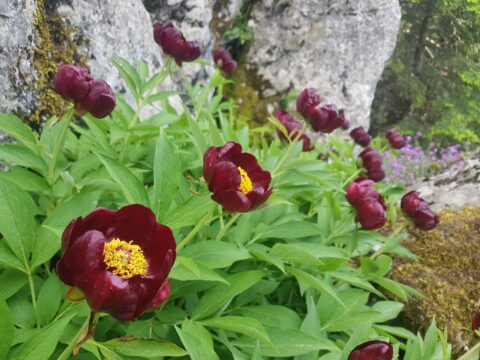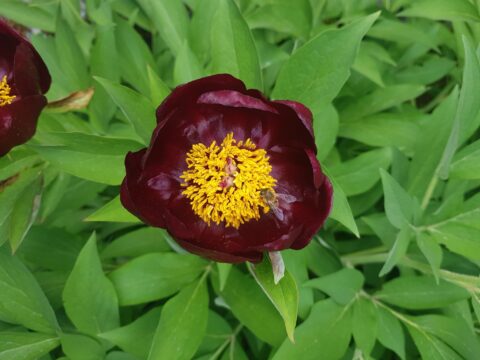[print_posts pdf=”yes” word=”yes” print=”no”]Paeonia parnassica(1)
Perennial herbs. Tap roots columnar; lateral roots tuberous or fusiform, sometimes tandem-fusiform. Stems usually green or green but pale purple in the lower part, sparsely to densely hirsute, 30-70 cm tall, with 4-9 green or greenish yellow scales at the base. Petioles and petiolules always hirsute; lower leaves biternate, with 9, rarely 8, leaflets, usually one or several leaflets segmented and thus leaflets/leaf segments 9-15, very rarely up to 25 in number, ovate, oblong or elliptic, cuneate to rounded at the base, nearly rounded to acute at the apex, 4.5—12 cm long, 1.5-7 cm wide, glabrous above, mostly densely, less frequently sparsely, villose beneath. Flowers solitary and terminal; involucrate bracts 1-3 in number, leaf-like; sepals 3-4 in number, with one caudate and the rest rounded at the apex, nearly orbicular, 2-4 cm long, 1.5-3.5 cm wide, green but purple at the periphery or entirely purple, densely villose on the abaxial side; petals 6-8 in number, dark purple, oblong or obovate, entire or 2—lobed at the apex, 4.5-6 cm long, 3-4.5 cm wide; filaments purple; anthers purple; disk 1-1.5 mm high, waved, tomentose; carpels 1-3, but mostly 2 in number, columnar-ellipsoid, 1.4-2.2 cm long, 0.5-0.7 cm in diameter, yellowish tomentose, hairs 2 mm long; stigmas sessile, red, c. 2 mm wide.
Chromosome number: n=20 (tetraploid).
Growing at the edges and in openings of Abies forests, or in sparse Abies forests, on limestones, at an altitude of 1,100—1,500 m. Found only in the mountains Parnassos and Elikonas (Helicon) of Greece.
The most remarkable characters of Paeonia parnassica are its very dark purple petals and purple anthers, which distinguish it from P. arietina. It has fewer leaflets/leaf segments (9—15, rarely up to 25) than P. arietina (11-25, rarely up to 32).
All images below taken in Parnassos National Park, Greece. Copyright: Φορέας Διαχείρισης Εθνικού Δρυμού Παρνασσού – Parnassos National Park MB
Paeonia parnassica in Greece, Parnassos National Park
Source: Φορέας Διαχείρισης Εθνικού Δρυμού Παρνασσού (Parnassos National Park Management Body) on Youtube.

Copyright Liberto Dario. “Paeonia parnassica on Mt. Parnassus (aka the king). Endemic to the mountain and nearby Mt.Elikonas.”

Copyright Liberto Dario. “Paeonia parnassica on Mt. Parnassus.”
- Hong, De-Yuan. “Peonies of the World. Taxonomy and phytogeography.” Kew: Royal Botanic Gardens, 2010, p. 227-228.[back to text]








































































OF never makes good carpals at my house, so the method I used was to use OF as a pollen…
I haven't followed up on it and I don't grow any of them myself. You're right to ask for it…
Any further information on Little Erna…it’s been 7 years.
I must say that I grow all my seedlings in potting soil, 24 seeds to a #3 pot. I keep…
I can't speak much about the "stimulating" properties of any of these products, but my sense is that the bacterial…
Danke für den interessanten Artikel. Werde ich auch mal anwenden für Spezies-Sämlinge und Jungpflanzen von Albiflora . Ich hoffe es…
Yes. But I'll have to admit that I haven't done a decent trial comparing seeds treated with GA3 and a…
Thanks Koen, I have also better results when I placed my seeds in constant temprature in my 'home made' climate…
Hi Koen, from years of growing in warmer climates. Just to mention a few. Red Charm a definite no go.…
Very Interesting Koen. Ga3 applications are very time sensitive. And in what I am reading that application timing differs from…